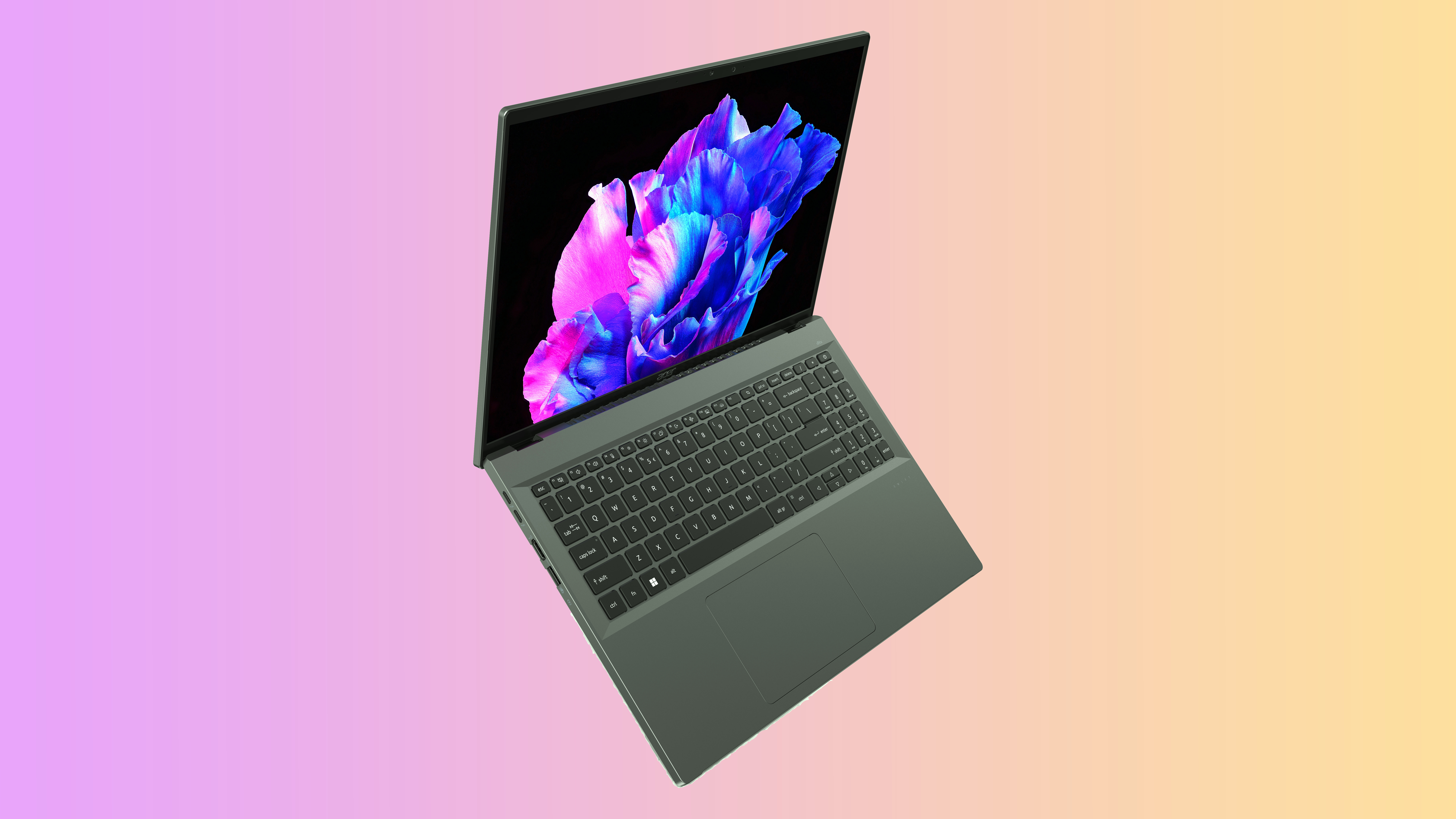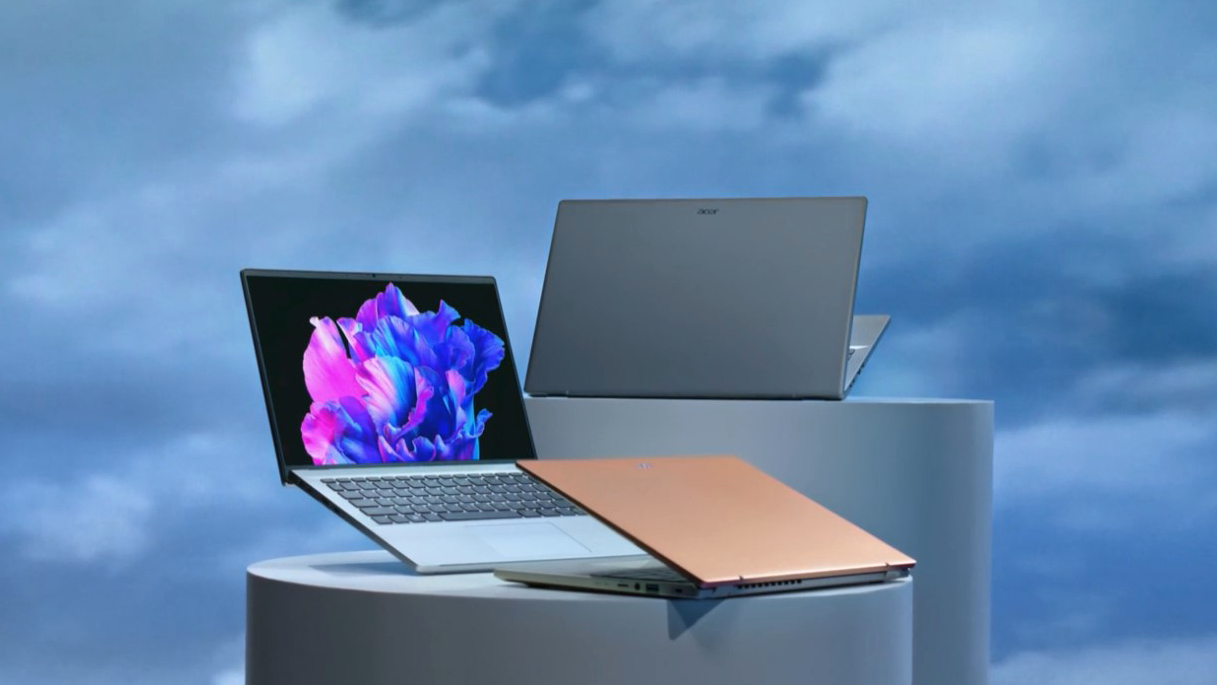Acer debuts new Swift Go ultraportables with OLED at CES 2023
OLED-equipped laptops (nearly) as light as a MacBook Air

CES 2023 is happening this week, and Acer is one of may PC vendors unveiling a slate of new laptops and PCs at the show. One of the most exciting is an all-new line of Swift Go laptops, ultraportables with OLED displays that are nearly as light as a MacBook Air.
These new Acer Swift Go ultraportables will go on sale in North America starting May 2023 for a starting price of $799, though they may become available in other territories sooner. They'll be available for purchase be sporting either 14-inch or 16-inch OLED touchscreens, which is exciting because OLED screens tend to look better than LCD displays by delivering brighter whites, deeper blacks, and sharper contrasts.
These Swift Go ultraportables join Acer's existing line of Swift laptops, most notably the Swift X laptops, which are also being refreshed with new OLED display options. One big difference is that Swift X laptops are heavier than the new Swift Go laptops, in part because they're available with discrete Nvidia or AMD graphics cards, gaming powerhouses that aren't available in these new Swift X laptops.
Acer Swift Go: Specs
| Row 0 - Cell 0 | Acer Swift Go 14 | Acer Swift Go 16 |
| Price | $849 to start | $799 to start |
| Display | 14-inch OLED 90Hz WQXGA+ (2880 x 1800)' IPS LCD 2.2K or WUXGA | 16-inch OLED 3.2K 120Hz (3200 x 2000); IPS LCD (WQXGA or WUXGA) |
| CPU | 13th Gen Intel Core i3-i7 | 13th Gen Intel Core i3-i7 |
| GPU | Intel Iris Xe integrated graphics | Intel Iris Xe integrated graphics |
| RAM | 8-16 GB LPDDR5 | 8-16 GB LPDDR5 |
| Storage | 256GB-1TB SSD | 256GB-1TB SSD |
| Webcam | 1440p | 1440p |
| Battery life | 9.5 hours (claimed) | 9.5 hours (claimed) |
| Weight | 2.76 pounds | 3.52 pounds |
| Size | 12.22 x 8.4 x 0.59 inches | 14.02 x 9.55 x 0.59 inches |
Acer Swift Go: Price and availability
The Acer Swift Go 16 is slated to go on sale in North America June 2023 for a starting price of $799. The smaller, lighter 14-inch model is more expensive, and will be available in North America in May 2023 for a starting price of $849.
Acer Swift Go: Design
Both the 14-inch and 16-inch models of Acer Swift Go sport aluminum chassis roughly 0.59 inches thick, and the lighter 14-inch model weighs just 2.76 pounds. That makes the 14-inch model nearly as thin and light as the MacBook Air 2022, which is just 0.44 inches thick and 2.7 pounds heavy.
That means that if you like the heft and feel of the Air but prefer Windows 11 or an OLED display, the 14-inch Acer Swift Go could be more compelling than Apple's lightest laptop.

Of course, the 16-inch Swift Go weighs well over 3 pounds (3.52, to be specific), which is reasonably light for a 16-incher. However, many 16-inch laptops have more power than the Swift Go, which is limited to 16GB of RAM, has no dedicated GPU and must rely on Intel's latest Raptor Lake 13th Gen CPUs for horsepower. Apple's 16-inch MacBook Pro 2021, for example, weighs 4.7 pounds but offers more potential RAM and the power of the Apple's M1 Ultra chip.
Get instant access to breaking news, the hottest reviews, great deals and helpful tips.
Acer Swift Go: Display
The most exciting aspect of these new Swift Go ultraportables is their optional OLED touchscreens, which offer higher resolutions and better image quality than the baseline IPS LCD display options.
The 14-inch Swift Go can be configured with up to a 14-inch 2.8K (2880 x 1800) OLED display with a 90Hz refresh rate. Acer claims the display on the 14-inch Go offers a 90% screen-to-body ratio and bezels as thin as 0.163 inches, which can be important if you don't like the distraction of thick black bars framing everything you do on-screen.
The 16-inch Swift Go has slightly thicker bezels and a bigger, higher-resolution display. It can be configured with up to a 16-inch 3.2K (3200 x 2000) display, with bezels as thin as 0.165 inches.
Acer claims both displays can achieve up to 500 nits of brightness (which would be quite bright, if true) and achieve 100% DCI-P3 color range. which (if true) would be better than most competing laptops.
Acer Swift Go: Performance
Both sizes of Acer's Swift Go ultraportable are configurable with up to an Intel Core i7-13700H CPU and up to 16GB of LPDDR5 RAM. That's more than enough power to tackle most day-to-day work tasks, and even some light gaming if you stick to games that aren't very demanding in the graphics department.
Acer Swift Go: Ports
Unfortunately, Acer hasn't (yet) disclosed the exact port counts on either of its new Swift Go laptops. Once we find out the full details, we'll update this section accordingly.
However, the company hasn't left us completely in the dark. In its CES 2023 press materials Acer claims both sizes of Swift Go will sport USB-C/Thunderbolt 4 ports, HDMI 2.1 outs, and microSD card readers.
Acer Swift Go: Webcam
Here's good news for folks who do a lot of video-conferencing: Both models of Swift Go will come with 1440p webcams that should make you look better than most laptop webcams, which tend to top out at 1080p. They also support Acer's proprietary noise reduction tech to boot.
Acer Swift Go: Battery life
Acer claims both sizes of Swift Go will last at least 9.5 hours on a full charge, which seems pretty reasonable given they both pack power-sipping 13th Gen Intel CPUs. Of course, we'll have to wait until we get one in for testing to say for sure how they hold up in our Tom's Guide battery tests.
Acer Swift Go: Outlook
These new Swift Go ultraportables look to be awfully compelling laptops if you're in the market for a lightweight Windows 11 machine with a gorgeous screen. Of course, we won't know for sure whether they can go toe-to-toe with the best laptops on the market until we go hands-on with one ourself.
We have some crack Tom's Guide team members on the show floor at CES 2023 this week, so that opportunity may come sooner than later — stay tuned!

Alex Wawro is a lifelong tech and games enthusiast with more than a decade of experience covering both for outlets like Game Developer, Black Hat, and PC World magazine. A lifelong PC builder, he currently serves as a senior editor at Tom's Guide covering all things computing, from laptops and desktops to keyboards and mice.
